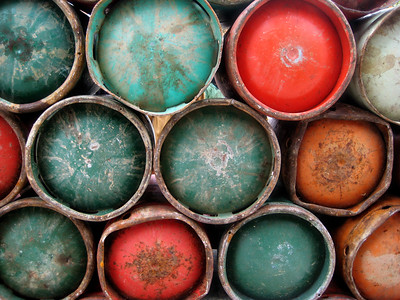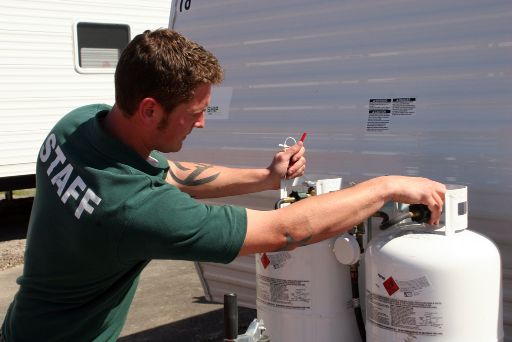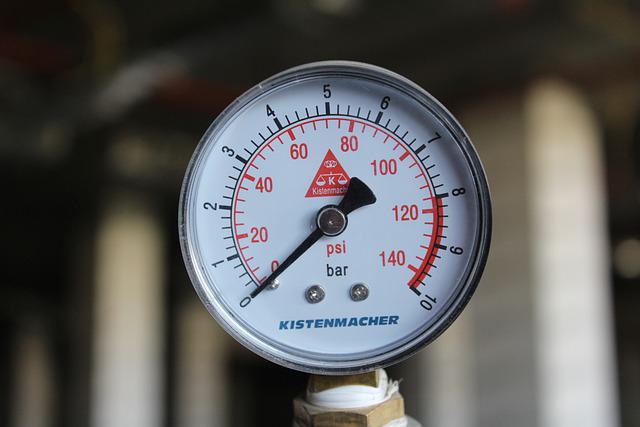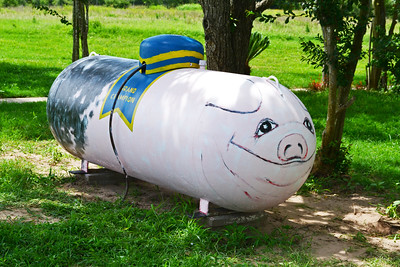
In general, it is not recommended to store propane tanks on their side. Propane tanks are designed to be stored in an upright position, with the valve at the top and the opening at the bottom. This is because propane is a liquefied gas, and the pressure inside the tank is what keeps the liquid in its proper place. When the tank is stored upright, the pressure inside the tank helps to keep the liquid propane at the bottom of the tank, where it can be easily drawn out through the valve.
If a propane tank is stored on its side, the pressure inside the tank may not be sufficient to keep the liquid propane at the bottom of the tank. This can cause the liquid propane to move around inside the tank and potentially block the valve, making it difficult or impossible to use the tank. In addition, storing a propane tank on its side can also increase the risk of damage to the tank and the valve, which can lead to leaks or other safety hazards.
It is important to store propane tanks in a safe and secure location, away from heat sources and flames, and to follow the manufacturer’s recommendations for storage. If you have any concerns about the proper storage of your propane tank, you should contact the manufacturer or a qualified professional for advice.
Propane tanks can be stored horizontally. But anyone who wants to do this must ensure that the safety relief valve is above the liquid level of the tank if stored on their side. Not doing so can lead to valve and tank damage.
When storing propane tanks on their side, it is important to be aware of the potential for leaks and the fast accumulation of fumes in the storage area. If a leak does occur, it is important to have proper ventilation in the area to disperse the fumes. Additionally, it is important to monitor the level of propane in the tank so that it does not get too low and cause the tank to become unstable.
[table id=3 /]
The relief valve valve can be damaged
When you use a small, portable propane tank, it’s important to keep it upright. Laying the tank on its side can cause the relief valve to malfunction. The relief valve is a safety feature that helps release pressure if the tank gets too hot. If the valve malfunctions, it could result in an explosion. To avoid this, always keep your propane tank upright. If you need to transport it, make sure it’s in a upright position. Once you get to your destination, set the tank down on a level surface and be careful not to knock it over.
Do store propane tanks on a dry, level surface
It is very important to store your propane tanks on a dry, level surface. This will help prevent the tank from leaking and will keep the pressure inside the tank consistent. If the tank is stored on an uneven or wet surface, it could lead to problems with the tank’s pressure regulator and cause the tank to leak.
When it comes to storing your propane tank, there are a few things you need to keep in mind. First and foremost, always store your tank on a dry, level surface. This will help ensure that the tank doesn’t fall over, which could lead to a dangerous situation. In addition, make sure that the area around the tank is well ventilated.
Propane is a flammable gas, so it’s important to have good airflow in the area where the tank is stored. If you’re going to be storing the tank for an extended period of time, consider investing in a steel cabinet. This will help protect the tank from the elements and extend its lifespan.
Never transport a propane cylinder in a sedan or SUV or on its side.
When it comes to securing a cylinder, you have a few options. You can use chain, rope, or other tie to secure the tanks at the base, to keep it in the vertical position during transport. Make sure that whatever you use is strong enough to hold the tank in place, and that it won’t slip or come loose during transport. You don’t want the cylinder tipping over or rolling around in the back of your car or SUV. In addition to securing the cylinder itself, you’ll also want to secure any valves or fittings that may be attached to it. This will help prevent any leaks or accidents during transport.
Tying down a propane cylinder is essential for safe transport. The cylinder should be secured at the base, near the foot ring, and at the top to prevent it from tipping over or rolling around. Tie-downs can be used to achieve this. Make sure the tie-downs are tight and secure so that the cylinder cannot move during transport.
Why is it important to keep your propane cylinders upright?
If you’ve ever seen a picture of a propane tank that’s been lying on its side, you know that they’re not meant to be stored that way. Propane cylinders must be kept upright at all times to prevent the gas from escaping. If a gas leak were to occur, it could result in an explosion or fire. So why is it so important to keep your propane cylinders upright?
When you use a propane-powered appliance, the cylinder must be in an upright position. This is because the pressure inside the cylinder is greater than the atmospheric pressure outside the cylinder. If the cylinder is not in an upright position, the valve at the top of the cylinder may not function properly and gas may leak out. It is also important to keep your propane cylinders upright because it prevents rusting and corrosion of the valves and fittings. When cylinders are stored on their side, the liquid propane can seep into the valve and corrode it. This can lead to leaks or even explosions.
Alternative Solutions and Best Practices for Horizontal Propane Storage
If you’re thinking of storing your propane tank on its side, there are safer alternatives and best practices to consider.
Using Horizontal Propane Tanks
- Why Use Them?: Some propane tanks are specially designed to lie flat. If you need to save space or if your setup demands it, look for these tanks.
- Valve Placement: These tanks have valves made for side storage. This means no surprise propane leaks.
- Where You Might See Them: RVs, some boats, and certain industries use these horizontal tanks because they fit better in tight spaces.
- Safety First: Just like upright tanks, horizontal tanks are tested for safety. Make sure you get a good quality one.
If You Must Store a Regular Tank Horizontally…
- Hold It Tight: Use brackets to keep the tank from rolling or moving. You don’t want it getting damaged or causing harm.
- Check It Often: A sideways tank can get damaged easier. Look for wear, rust, or dents regularly.
- Protect the Valve: Cover the tank’s valve. This stops accidental openings or breaks.
- Use a Safety Cage: This gives an extra layer of protection, shielding the tank from bumps or hits.
- Avoid Sparks: Keep the tank away from anything that might start a fire.
- Watch the Pressure Valve: When a tank’s on its side, the pressure valve might sit in the liquid propane. Make sure it’s working right and not submerged.
Remember, it’s always best to store propane tanks upright. But if you have to go horizontal, follow these guidelines to stay safe.
Safety Precautions
While propane tanks are designed to be stored upright, they can be stored on their side if necessary. There are a few things to keep in mind if you need to store your propane tank on its side. First, make sure the tank is properly secured so it doesn’t tip over.
Second, check the tank for leaks before storing it on its side. If there are any leaks, they will need to be fixed before the tank can be stored. Finally, when you’re ready to use the propane from the tank, make sure to shake it so the gas evenly distributes itself before opening the valve.
Never drop propane tanks when transporting or handling them as the impact can make the tank to explode accidentally.
Other Safety Concerns
Laying a propane tank on its side may seem harmless, but it can introduce a few risks. Here’s a breakdown of the main safety concerns associated with horizontal storage:
1. Risk of Liquid Propane Reaching the Pressure Relief Valve:
- What’s the Issue?: Typically, propane tanks have a pressure relief valve designed to release gas if the internal pressure gets too high. If the tank is on its side, liquid propane might reach this valve.
- Why It’s a Concern: Releasing liquid propane is much more dangerous than releasing gas. If liquid propane is expelled, it can quickly vaporize and expand, increasing the risk of a fire or explosion.
2. Changes in Tank Pressure Dynamics When Oriented Horizontally:
- Pressure Distribution: In a vertically stored tank, gas sits on top, and liquid propane is at the bottom. When horizontal, this dynamic changes, potentially affecting the pressure equilibrium.
- Temperature Factors: The pressure inside a propane tank is sensitive to temperature. With a larger surface area exposed when horizontal, temperature changes might impact the tank’s internal pressure differently than when it’s vertical.
- Safety Implications: Unexpected pressure changes can strain the tank’s structure and the functionality of safety valves. This can increase the risk of leaks or, in extreme cases, cause the tank to rupture.
3. Potential for Uneven Wear or External Damage:
- Design Intent: Propane tanks are designed to stand upright. Their base is constructed to handle the weight and environmental factors like rain or debris.
- Wear and Tear: When a tank is horizontal, parts not designed to be in constant contact with the ground or surface are exposed. This can lead to uneven wear, rusting, or corrosion over time.
- External Threats: Horizontally stored tanks may be more susceptible to damage from external factors, like being accidentally kicked, bumped by vehicles, or even potential punctures if placed on uneven terrain.
However, It is Not Recommended to Do So?
Propane tanks can be stored on their side, but it is not recommended. When stored on their side for long period of time, the tanks can develop leaks. These leaks can be dangerous, as propane is a highly flammable gas. If a leak develops, you can easily smell it, it is important to immediately move the tank to a safe location, away from any flames or heat sources.
Main Reason is that it Can Cause the Gas to Escape from the Tank Faster
The main reason that propane tanks should not be stored on their side is that it can cause the gas to escape from the tank faster. When the gas is stored in a tank horizontally, the pressure inside the tank is not evenly distributed. This can cause the tank to develop leaks, and the gas to escape. Additionally, storing the tank on this position can make it more likely to tip over and cause an accident.
If You Must store the Tanks on their Side, Make Sure to Do so in a Well-Ventilated Area
While it is possible to store a propane tank on its side, it is not recommended unless it is in a well-ventilated area. This is because propane is a highly flammable gas and if there is a leak, it could easily ignite, causing a fire or explosion. If you must store a tank on its side, make sure to do so in a well-ventilated area where there are no potential ignition sources.
Also, ensure that the tank is not in contact with the ground
When storing propane tanks there are a few things to keep in mind. First, ensure that the tank is not in contact with the ground. Second, make sure that the valve is closed and that the tank is properly secured. Third, check the expiration date on the tank to ensure that it is still in good condition. Finally, be sure to store the tank in a well-ventilated area.
Practical Considerations for Horizontal Storage
Storing propane tanks horizontally isn’t the usual way, but sometimes it might be necessary. Here’s what you need to think about:
When Might You Need to Store Propane Horizontally?
- Space Constraints: Maybe you’re short on space, like in an RV or a boat, and a tank standing up just won’t fit.
- Specific Equipment Design: Some machines or tools are designed to work with horizontally stored tanks.
- Transportation Needs: Sometimes, for safety or space reasons, propane tanks are laid flat during transport.
What to Do If You Can’t Avoid Horizontal Storage:
- Use the Right Tank: Ideally, go for tanks specifically made for horizontal storage. They’re designed to be safe and effective in that position.
- Secure It Properly: Ensure your tank won’t roll or shift. Use brackets or other securing tools.
- Check Regularly: A horizontally-stored tank might face different wear and tear. Keep an eye on it for any damage or issues.
- Mind the Valves: Ensure the tank valves are accessible and functional. You don’t want any unexpected leaks!
Impact on Propane Quality and Performance
You might wonder if lying a propane tank on its side affects the propane inside. Let’s dive in:
Does Orientation Change Propane’s Properties?
- Short Answer: No. Whether upright or sideways, the propane inside remains the same. But the way it’s accessed and released can differ.
- Liquid vs. Gas: Propane tanks contain both liquid and gas. When horizontal, there’s a higher chance you might release liquid propane instead of its gaseous form, especially if the valves aren’t designed for side storage.
Long-Term Effects of Horizontal Storage:
- Potential for More Wear: The base of propane tanks is designed to handle being set down. The sides? Not as much. Long-term horizontal storage might lead to more external wear.
- Valve Issues: If a tank not designed for horizontal storage is kept on its side for too long, the pressure relief valve might malfunction, especially if it’s submerged in liquid propane.
- Consistent Pressure: One benefit is that horizontally stored tanks, especially larger ones, can offer more consistent pressure in colder temperatures since there’s a larger surface area in contact with the propane.
While horizontal storage can be done, it’s crucial to know the why’s and how’s to ensure safety and proper function. If you have to store a tank sideways, make sure you’re doing it right!

Mike is an experienced propane technician with over 15 years of professional experience in the field. He has dedicated his career to helping customers with their propane needs, from installation to maintenance and repair. Together with Jeremy, he co-founded this website to provide useful information and guidance to customers seeking reliable propane services.




